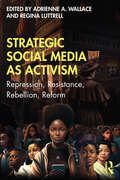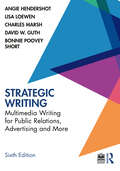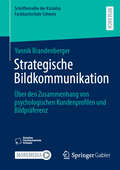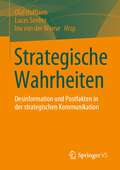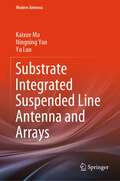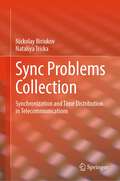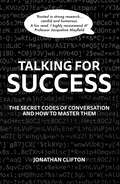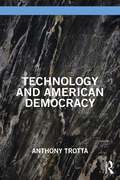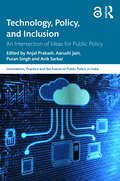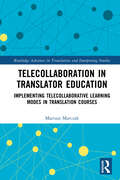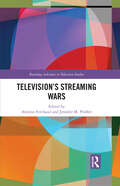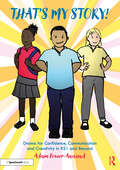- Table View
- List View
Strategic Social Media as Activism: Repression, Resistance, Rebellion, Reform
by Adrienne A. Wallace and Regina LuttrellDrawing on a range of theoretical and empirical perspectives, this volume examines the roles strategic communications play in creating social media messaging campaigns designed to engage in digital activism. As social activism and engagement continue to rise, individuals have an opportunity to use their agency as creators and consumers to explore issues of identity, diversity, justice, and action through digital activism. This edited volume situates activism and social justice historically and draws parallels to the work of activists in today’s social movements such as modern-day feminism, Black Lives Matter, #MeToo, Missing Murdered Indigenous Women, and We Are All Khaled Said. Each chapter adds an additional filter of nuance, building a complete account of mounting issues through social media movements and at the same time scaffolding the complicated nature of digital collective action. The book will be a useful supplement to courses in public relations, journalism, social media, sociology, political science, diversity, digital activism, and mass communication at both the undergraduate and graduate level.
Strategic Social Media as Activism: Repression, Resistance, Rebellion, Reform
Drawing on a range of theoretical and empirical perspectives, this volume examines the roles strategic communications play in creating social media messaging campaigns designed to engage in digital activism. As social activism and engagement continue to rise, individuals have an opportunity to use their agency as creators and consumers to explore issues of identity, diversity, justice, and action through digital activism. This edited volume situates activism and social justice historically and draws parallels to the work of activists in today’s social movements such as modern-day feminism, Black Lives Matter, #MeToo, Missing Murdered Indigenous Women, and We Are All Khaled Said. Each chapter adds an additional filter of nuance, building a complete account of mounting issues through social media movements and at the same time scaffolding the complicated nature of digital collective action. The book will be a useful supplement to courses in public relations, journalism, social media, sociology, political science, diversity, digital activism, and mass communication at both the undergraduate and graduate level.
Strategic Writing: Multimedia Writing for Public Relations, Advertising and More
by Angie Hendershot Lisa Loewen Charles Marsh David W. Guth Bonnie Poovey ShortFeaturing examples of strategic writing throughout the book, this practical, multidisciplinary text takes students through the fundamental concepts, genres, and techniques of writing for strategic communicators to connect with their publics. The book contains concise instructions for writing the key multimedia documents in strategic communication, each with an example in the text. Short, practice-oriented chapters each cover a key theme, principle or writing topic. This sixth edition features: new and more diverse examples; additional references on legal and ethical guidance, technical tools and other resources used by practicing professionals; a new Audience Persona chapter; and incorporation of digital trends, such as increased use of images, video and user-generated content as well as evolutions in mobile marketing and other emerging platforms. Strategic Writing, Sixth Edition is an essential textbook for undergraduate courses in public relations, advertising and strategic communication writing, particularly those that take a multidisciplinary approach. Online resources are also included to support instructors and students. Faculty will find sample assignments with rubrics and lecture slides. Students will find practice quizzes for each section; nine-step strategic writing process guidance with helpful links for each step; and examples, templates and online articles demonstrating strategic writing in practice. Please visit www.routledge.com/cw/hendershot.
Strategic Writing: Multimedia Writing for Public Relations, Advertising and More
by Angie Hendershot Lisa Loewen Charles Marsh David W. Guth Bonnie Poovey ShortFeaturing examples of strategic writing throughout the book, this practical, multidisciplinary text takes students through the fundamental concepts, genres, and techniques of writing for strategic communicators to connect with their publics. The book contains concise instructions for writing the key multimedia documents in strategic communication, each with an example in the text. Short, practice-oriented chapters each cover a key theme, principle or writing topic. This sixth edition features: new and more diverse examples; additional references on legal and ethical guidance, technical tools and other resources used by practicing professionals; a new Audience Persona chapter; and incorporation of digital trends, such as increased use of images, video and user-generated content as well as evolutions in mobile marketing and other emerging platforms. Strategic Writing, Sixth Edition is an essential textbook for undergraduate courses in public relations, advertising and strategic communication writing, particularly those that take a multidisciplinary approach. Online resources are also included to support instructors and students. Faculty will find sample assignments with rubrics and lecture slides. Students will find practice quizzes for each section; nine-step strategic writing process guidance with helpful links for each step; and examples, templates and online articles demonstrating strategic writing in practice. Please visit www.routledge.com/cw/hendershot.
Strategische Bildkommunikation: Über den Zusammenhang von psychologischen Kundenprofilen und Bildpräferenz (Schriftenreihe der Kalaidos Fachhochschule Schweiz)
by Yannik BrandenbergerIn einer sich rasant verändernden Marketinglandschaft wird die Bedeutung einer authentischen Verbindung zwischen Unternehmen und Konsumenten immer dringlicher. Statt mit Inhalten zu überfluten, liegt die Herausforderung darin, durch gezielte visuelle Kommunikation eine tiefere Bindung aufzubauen. Diese Herausforderung wird besonders in der fehlenden Anpassung von Bildern an die psychologischen Profile der Zielgruppe deutlich, für die bisher kein empirisch validiertes Modell existiert. In diesem Buch wird ein tiefer Einblick in den Zusammenhang zwischen psychologischen Kundenprofilen und Bildpräferenzen durch die Untersuchung und Weiterentwicklung des EIC-Modells gewonnen. Die empirischen Ergebnisse, gewonnen aus einer Studie mit 95 Teilnehmenden, bestätigen diese Verbindung und eröffnen neue Perspektiven für die strategische Bildkommunikation. Als Resultat dieser Forschung präsentiert sich das ICS-Modell – ein Instrument, das Fotograf*innen und Marketingexpert*innen befähigt, die Bildkommunikation gezielt auf Zielgruppen auszurichten. Dieses Buch bietet nicht nur einen Einblick in die theoretischen Grundlagen, es regt auch dazu an, wie diese Erkenntnisse in der Praxis für eine wirkungsvolle visuelle Kommunikation genutzt werden können.
Strategische Wahrheiten: Desinformation und Postfakten in der strategischen Kommunikation
by Olaf Hoffjann Lucas Seeber Ina von der WenseStrategische Kommunikation zielt mit ihren kontingenten Wirklichkeitsbeschreibungen seit jeher auf gesellschaftliche Wahrheitsmodelle. Wie häufig gesellschaftliche Wahrheitsmodelle auf strategische Kommunikationsbemühungen zurückgehen, auf Unwahrhaftigkeit beruhen und damit zumindest zeitweise zu strategischen Wahrheiten werden, zeigen eindrucksvoll zwischenzeitlich geglaubte Wahrheiten, die sich als Lüge entpuppt haben: von Walter Ulbrichts „Niemand hat die Absicht, eine Mauer zu errichten“ über Hitlers Tagebücher bis hin zu den Massenvernichtungswaffen im Irak. Die erfolgreichen Kampagnen der Brexiteers und von Donald Trump 2016 haben diesem Thema zu neuer und bislang ungeahnter Aufmerksamkeit verholfen. Während die Themen Desinformation und postfaktische Gesellschaft die Journalismus-, politische Kommunikations- und Medienethikforschung aktuell zu dominieren scheinen, ist das Schweigen der deutschsprachigen und internationalen PR- und Organisationskommunikationsforschung auffällig. Dies ist umso bemerkenswerter, weil die PR-Wissenschaft in der Vergangenheit immer wieder versucht hat, ihren Gegenstand zu schärfen, indem sie sich am Begriff der Propaganda abgearbeitet hat. Daraus müsste eigentlich eine Affinität für das Thema Desinformation resultieren. Aber genau das Gegenteil ist offensichtlich der Fall: Hat sich die PR-Wissenschaft gerade deshalb nicht mit Desinformation beschäftigt, weil sie sich so dezidiert von Propaganda und darin eingeschlossenen desinformierenden und manipulativen Techniken abgrenzen will? Was sind die Gründe hierfür? Glauben wir, bereits alles zum Thema gesagt zu haben? Liegt dies daran, dass sich die PR- und Organisationskommunikationsforschung seit jeher vor allem für Unternehmen und weniger für politische und Non-Profit-Organisationen interessiert? Oder fühlen wir uns hier schlicht und ergreifend nicht zuständig? Es scheint offenkundig höchste Zeit zu sein, sich wieder eingehend mit Fragen der Desinformation aus der Perspektive der strategischen Kommunikationsforschung zu befassen. Die Beiträge des Tagungsbandes fokussieren hierzu auf neue theoretische Perspektiven, normative Bewertungen und empirische Befunde.
The Structure of Ideas: Mapping a New Theory of Free Expression in the AI Era
by Jared SchroederIn his historic 1919 dissent, Justice Oliver Wendell Holmes named, and thus catalyzed the creation of, the marketplace of ideas. This conceptual space has, ever since, been used to give shape to American constitutional notions of the freedom of expression. It has also eluded clear definition, as jurists and scholars have contested its meaning for more than a century. In The Structure of Ideas, Jared Schroeder takes on the task of mapping the various iterations of the marketplace, from its early foundations in Enlightenment beliefs in universal truths and rational actors, to its increasingly expansive parameters for protecting expression in the arenas of commercial, corporate, and online speech. Schroeder contends that in today's information landscape, marked by the rapid emergence of artificial intelligence, the marketplace is failing to provide a space where truths succeed and falsity fails. AI and networked technologies have thoroughly overpowered all traditional pictures of the marketplace up to now. Schroeder proposes various theoretical interventions that would revise the marketplace for the current moment, and concludes by describing a new space built around algorithms, AI, and virtual communication.
The Structure of Ideas: Mapping a New Theory of Free Expression in the AI Era
by Jared SchroederIn his historic 1919 dissent, Justice Oliver Wendell Holmes named, and thus catalyzed the creation of, the marketplace of ideas. This conceptual space has, ever since, been used to give shape to American constitutional notions of the freedom of expression. It has also eluded clear definition, as jurists and scholars have contested its meaning for more than a century. In The Structure of Ideas, Jared Schroeder takes on the task of mapping the various iterations of the marketplace, from its early foundations in Enlightenment beliefs in universal truths and rational actors, to its increasingly expansive parameters for protecting expression in the arenas of commercial, corporate, and online speech. Schroeder contends that in today's information landscape, marked by the rapid emergence of artificial intelligence, the marketplace is failing to provide a space where truths succeed and falsity fails. AI and networked technologies have thoroughly overpowered all traditional pictures of the marketplace up to now. Schroeder proposes various theoretical interventions that would revise the marketplace for the current moment, and concludes by describing a new space built around algorithms, AI, and virtual communication.
Studying Verbal Irony and Sarcasm: Methodological Perspectives from Communication Studies and Beyond
by Natalia Banasik-Jemielniak Piotr Kałowski Maria ZajączkowskaThis volume provides a comprehensive yet accessible introduction to the phenomenon of verbal irony and sarcasm and the methodological aspects of its study. The chapters employ quantitative and qualitative measures of the use of verbal irony and sarcasm in both adults and children, with methods ranging from questionnaires and comment elicitation through experimental studies to a qualitative analysis of naturalistic data. By examining the phenomena in a range of contexts, the volume also show that cultural norms of communication may affect both the use and understanding of irony in specific ways and should therefore be taken into account in research.
Substrate Integrated Suspended Line Antenna and Arrays (Modern Antenna)
by Kaixue Ma Ningning Yan Yu LuoThis book delves deeply into the substrate integrated suspended line antenna technologies and evaluates its potential to replace conventional three-dimensional (3D) metal-based antennas. Over the years, studies on substrate integrated suspended line antennas have captivated engineers and scientists from the antennas and related engineering fields, all aiming to achieve low-cost and low-loss characteristics. The book establishes a fundamental framework for this topic, while emphasizing the importance of substrate integrated suspended line antennas in the wireless communication and radar systems. It is designed for undergraduate and graduate students who are interested in antenna technology, researchers investigating substrate integrated technology, and antenna engineers working on low-cost and low-loss antennas and arrays.
Sync Problems Collection: Synchronization and Time Distribution in Telecommunications
by Nickolay Biriukov Nataliya TriskaThis textbook clarifies synchronization issues in telecommunications in an easy-to-follow way, focusing less on theory and more on practical aspects. The book is intended for a wide range of readers interested in the basic synchronization concepts in their wide application for development, maintenance, and conformity assessment of telecommunications equipment and networks. The authors show how, though synchronization in telecommunications has experienced rapid development, the foundational theory and the basic definitions, mathematical tools, and well-developed “classical” technologies have remained. The authors have studied the ITU-T, ETSI, IEEE standards, and extracted practical topics of synchronization. The collection of numerous training problems, practical examples, and case studies help the readers not only to find the answers to their current questions but also to get a common view of synchronization’s role in the modern telecommunications. The book is geared towards students of telecommunications but can also be useful for telecom engineers and for training/workshops for telecom engineers concerning synchronization topics.
The Syrian Conflict in the News: Coverage of the War and the Crisis of US Journalism (Political Communication and Media Practices in the Middle East and North Africa)
by Gabriel HulandThe Syrian conflict constitutes one of the most covered events in this century. Although the coverage of the Syrian uprising and civil war alternated between periods of saturation and silence, it is indisputable that they received an enormous amount of media attention. The Syrian Conflict in the News analyses the coverage of the Syrian conflict in the New York Times, the Washington Post, and the Wall Street Journal, focusing on how the three newspapers framed six key events in Syria from March 2011 to April 2018, including the Ghouta chemical attack, the Russian intervention in Syria and US-led airstrikes. Gabriel Huland argues that US foreign policy dominates the frames of the conflict, which suggests that mainstream newspapers are excessively indexed to elite narratives. In the United States, the Syrian crisis prompted an intense debate about the appropriate degree of US involvement in the civil war and how the country should behave in the face of growing Russian and Iranian influence in the Middle East. The overreliance on elite narratives resulted in the underrepresentation of local voices and other players who were in a more advantaged position to devise solutions to the conflict. By analysing the frames of the Syrian uprising and civil war in three mainstream newspapers and the relationship between media and international conflicts, The Syrian Conflict in the News sheds light on crucial aspects of the crisis currently pervading US journalism.
Talking For Success: The Secret Codes of Conversation – and How to Master Them
by Dr Jonathan CliftonImagine if you could always get what you want – just by speaking properly. For decades academics have been slowly cracking the secret codes of spoken language used by successful speakers to achieve their aims. Now in this practical and eye-opening guide, Jonathan Clifton, a linguistics expert who has been decoding language for decades, identifies these below-the-radar tactics, explaining how and why they work. And he sets out 100 ways you can successfully apply these secret codes of spoken language yourself, and achieve your goals in life, love and work. Debate, small talk, negotiation, advertising, apologies, presentations, and news interviews, all are revealed in Dr Clifton's prescription for conversational joy. Dr Clifton, an associate professor at the Université Polytechnique Hauts-de-France, France, has been teaching communication to students at universities in Europe and India for the past 25 years. However, he has come to realise that academics are often writing only for each other and their work is often obscure and inaccessible for a wider public. To spread the practical benefits of linguistics, he is bringing the insights of his research to a popular audience in a clear and jargon-free manner. His message is that if you want to improve your communication skills, you must study how other people use language as they go about their daily business. Then you'll be able to crack the codes of conversation for yourself – and talk your way to success. Imagine what a difference that could make to your life. Just by applying some thought and the right words. Reviews "Drawing from years of research and university teaching, Jonathan Clifton masterfully guides the reader through the secret codes of conversation - without the academic jargon. Through easy-to-follow examples taken from contemporary scenarios, this book encourages you to notice the subtlest of cues in language, and it equips you with concrete communication strategies, one hundred of them to be specific. From celebrity interviews to police negotiations, from adverts to everyday chatter - if you ever wondered how people really communicate and how they achieve their goals, you won't be able to put this book down!" Erika Darics, language consultant and Professor of Applied Linguistics, University of Groningen, The Netherlands. "Jonathan Clifton is an outstanding scholar, as his many academic publications attest. Yet, what makes him truly stand out from the 'academic crowd' is his ability to translate complex analyses into plain language. Combine this with an excellent nose for captivating cases, and you have a recipe for success, as this book shows! Because seriously, who wouldn't want to know how to crack the language codes as used by the likes of Boris Johnson, Donald Trump, and Meghan and Harry?! Dorien Van De Mieroop, Professor of Linguistics, Leuven University, Belgium." "This wise book resonates with academics and professionals by showing how communication shapes reality. "TALKING FOR SUCCESS: The Secret Codes of Conversation and How to Master Them" is a one-of-a-kind guide to communication strategy that is both specific and actionable. These very valuable insights are also rooted in strong research but shared in an engaging and conversational tone. To boot, the candid, and sometimes humorous delivery, is a fun read. I highly recommend it!" Jacqueline Mayfield, PhD, Professor Emeritus of Management, Texas A & M International University. Co-Editor, the International Journal of Business Communication
TCP, UDP und QUIC Internals: Protokolle und Programmierung
by Peter MandlDas Lehrbuch vermittelt praxisbezogen wichtige Grundkonzepte der Datenkommunikation mit einem Fokus auf den wichtigsten Transportprotokollen des Internets und auf der Entwicklung verteilter Anwendungen. Besonders ausführlich betrachtet der Autor die Transportprotokolle TCP und UDP, aber auch das neue, ursprünglich von Google für die Webkommunikation mit HTTP/3 entwickelte und inzwischen standardisierte Protokoll QUIC wird in der 2. Auflage ausführlich und verständlich erläutert. Dabei werden auch die zugrundeliegenden Kommunikationskonzepte anschaulich beschrieben. Um die Vorteile von QUIC im Vergleich zu TCP zu verstehen, werden auch die Grundlagen des Transport Layer Security (TLS) Protokolls, das in QUIC nun bereits integriert ist, in der vorliegenden 2. Auflage eingeführt. Die Nutzung von Transportmechanismen in der Programmierung eigener Kommunikationsanwendungen über die Socket API wird ebenfalls mit vielen Beispielen vor allem in Java, aber auch grundlegend in C erläutert. Neben den wesentlichen Protokollmechanismen und Zusammenhängen der betrachteten Protokolle weist der Autor auf die Möglichkeiten der Protokolloptimierung hin. Dadurch wird das Buch zu einem praktischen Ratgeber, der jederzeit zur Konfiguration der komplexen Protokollimplementierungen in Universalbetriebssystemen wie Linux, Windows oder macOS herangezogen werden kann.Die komplexen Sachverhalte werden verständlich erklärt und helfen dabei, die konkreten Protokollimplementierungen besser zu nutzen. Der Schwerpunkt des Buches liegt auf den praktisch relevanten Themen, aber auch grundlegende Aspekte werden erläutert. Viele Bilder veranschaulichen die Protokollmechanismen. Eine Sammlung von Kontrollfragen inklusive Musterlösungen erleichtert die Nachbearbeitung des Stoffes. Komplettiert wird das Buch durch umfangreiches Online-Zusatzmaterial. Lehrende können darüber hinaus auf Anfrage Präsentationsfolien zu den behandelten Themen beziehen.Das Buch richtet sich an Studierende der Informatik und Wirtschaftsinformatik sowie anderer Fachrichtungen mit Schwerpunkt Informationsverarbeitung und an Praktiker*innen wie Softwareentwickler*innen und Netzwerkadministrator*innen.Der Inhalt• Einführung in die Grundbegriffe der Datenkommunikation• Grundkonzepte der Transportschicht• Transportprotokolle TCP, UDP und QUIC• Einführung in das Transport Layer Security (TLS) Protokoll• Programmierung von Socket-Anwendungen
Technical Writing for Software Developers: Enhance communication, improve collaboration, and leverage AI tools for software development
by Chris ChinchillaElevate your software development process with expert technical writing skills, fostering clarity, collaboration, and successful product outcomesKey FeaturesOptimize documentation workflows with collaborative version-controlled "docs-as-code" tooling optionsEngage with interactive learning modules embedded throughout the bookImprove software quality as a lead developer through effective communication in documentationPurchase of the print or Kindle book includes a free PDF eBookBook DescriptionEffective documentation is key to the success of products in remote software development teams, facilitating clear instructions that benefit the entire development team. Technical Writing for Software Developers lays a solid foundation of essential grammar, providing language tips and explaining how precise writing enhances documentation, and walks you through the fundamental types and styles of documentation. Starting with an exploration of the current state of the tech writing industry and its significance in both the software and hardware realms, you’ll master the building blocks of technical writing, exploring tooling choices and style guides, and create dynamic multimedia-laden documentation. This book equips you with valuable insights into the writing and feedback process to ensure continuous improvement. Additionally, you’ll take a peek at the emerging trends and technologies, including AI tools, shaping the future of technical writing. By the end of this technical writing book, you’ll have developed the expertise you need to tackle documentation requests effectively, armed with the knowledge of the best approach for documenting any topic, encompassing text, media elements, structure, and appropriate tools. The skills acquired will enable you to achieve seamless teamwork, enhanced project efficiency, and successful software development.What you will learnCreate engaging multimedia-rich documentationUnderstand the types and styles of documentationDiscover grammar and language tips for clear communicationStreamline your documentation process with the right tooling choiceMaster the writing and feedback process for continuous improvementExplore automation techniques for efficient documentation workflowsEmbrace AI-powered tools for enhanced technical writingWho this book is forThis book is for software developers who want to improve their technical writing prowess. Whether you are a junior developer looking to refine your documentation skills or a professional striving for smoother collaboration, this resource equips you with all the essential knowledge and practical insights you need. Covering everything from creating clear documentation to enhancing career prospects, this book caters to a diverse range of software developers, including programmers, software architects, and software engineers looking to streamline the product development process and save time.
Technology and American Democracy
by Anthony TrottaThe growth and proliferation of technology in American society places new demands on the U.S. government and the health of its democracy, affecting both policymaking and public administration. Technology and American Democracy explores the underpinning democratic theories, including constitutional justifications, that guide decision makers during the application of Information Technology (IT) in governance to promote democratic principles such as transparency and accountability. The book examines the capacity of IT to facilitate deliberative democracy, alter modern bureaucratic structures and functions, and affect areas of public policy including public budgeting and performance measurement. Author Anthony Trotta demonstrates the ways in which technology creates new problems for contemporary government, including a discussion of virtual currency and its possible issues that must be addressed by the public sector. The discussion avoids highly technical language and confusing industry jargon, focusing instead on explaining important concepts in an accessible fashion, applicable to a broad spectrum of readers. Technology and American Democracy is required reading for students enrolled in courses on politics, public administration, and public policy.
Technology and American Democracy
by Anthony TrottaThe growth and proliferation of technology in American society places new demands on the U.S. government and the health of its democracy, affecting both policymaking and public administration. Technology and American Democracy explores the underpinning democratic theories, including constitutional justifications, that guide decision makers during the application of Information Technology (IT) in governance to promote democratic principles such as transparency and accountability. The book examines the capacity of IT to facilitate deliberative democracy, alter modern bureaucratic structures and functions, and affect areas of public policy including public budgeting and performance measurement. Author Anthony Trotta demonstrates the ways in which technology creates new problems for contemporary government, including a discussion of virtual currency and its possible issues that must be addressed by the public sector. The discussion avoids highly technical language and confusing industry jargon, focusing instead on explaining important concepts in an accessible fashion, applicable to a broad spectrum of readers. Technology and American Democracy is required reading for students enrolled in courses on politics, public administration, and public policy.
Technology, Policy, and Inclusion: An Intersection of Ideas for Public Policy (Innovations, Practice and the Future of Public Policy in India)
by Anjal Prakash Aarushi Jain Puran Singh Avik SarkarTechnology, Policy, and Inclusion looks at the intersections between public policy and technology in India. It explores the barriers in instituting effective governance and development and examines how these can be mitigated through technological interventions in developing countries. Increased digitisation of the economy has added to the development challenges in India and issues such as exclusion and social inequality. This volume stresses the need for governments to leverage technology to bring more vulnerable and marginalised groups into the fold of financial and social inclusion. It also focuses on the importance of regulation for a responsible integration of technologies and minimising risks. The book includes examples and case studies from different areas including management of the COVID-19 pandemic through digital means, real estate digital infrastructure, digital census, e-markets for farmers, and government interventions that use technology to deliver financial services in remote areas of the country. It also outlines various solutions for fostering equity and socio-economic development. Part of the Innovations, Practice and the Future of Public Policy in India series, this volume will be of interest to students and researchers of public policy, political science, development studies, and sociology as well as policy professionals and technocrats. This book is freely available as a downloadable Open Access PDF at http://www.taylorfrancis.com under a Creative Commons (CC-BY-NC-ND) 4.0 license.
Technology, Policy, and Inclusion: An Intersection of Ideas for Public Policy (Innovations, Practice and the Future of Public Policy in India)
by Anjal Prakash, Aarushi Jain, Puran Singh, and Avik SarkarTechnology, Policy, and Inclusion looks at the intersections between public policy and technology in India. It explores the barriers in instituting effective governance and development and examines how these can be mitigated through technological interventions in developing countries. Increased digitisation of the economy has added to the development challenges in India and issues such as exclusion and social inequality. This volume stresses the need for governments to leverage technology to bring more vulnerable and marginalised groups into the fold of financial and social inclusion. It also focuses on the importance of regulation for a responsible integration of technologies and minimising risks. The book includes examples and case studies from different areas including management of the COVID-19 pandemic through digital means, real estate digital infrastructure, digital census, e-markets for farmers, and government interventions that use technology to deliver financial services in remote areas of the country. It also outlines various solutions for fostering equity and socio-economic development. Part of the Innovations, Practice and the Future of Public Policy in India series, this volume will be of interest to students and researchers of public policy, political science, development studies, and sociology as well as policy professionals and technocrats. This book is freely available as a downloadable Open Access PDF at http://www.taylorfrancis.com under a Creative Commons (CC-BY-NC-ND) 4.0 license.
Telecollaboration in Translator Education: Implementing Telecollaborative Learning Modes in Translation Courses (Routledge Advances in Translation and Interpreting Studies)
by Mariusz MarczakThis volume provides a comprehensive treatment of telecollaboration as a learning mode in translator education, surveying the state-of-the-art, exploring its distinctive challenges and affordances and outlining future directions in both theoretical and practical terms. The book begins with an overview of telecollaboration and its rise in prominence in today’s globalised world, one in which developments in technology have significantly impacted practices in professional translation and translator education. The volume highlights basic design types and assessment modes and their use in achieving competence-based learning outcomes, drawing on examples from seven telecollaboration projects. In incorporating real-life research, Marczak draws readers’ attention to not only the practical workings of different types of projects and their attendant challenges but also the opportunities for educators to diversify and optimize their instructional practices and for budding translators to build competence and better secure their future employability in the language service provision industry. This volume will be a valuable resource for students and researchers in translation studies, particularly those with an interest in translator education and translation technology, as well as stakeholders in the professional translation industry.
Telecollaboration in Translator Education: Implementing Telecollaborative Learning Modes in Translation Courses (Routledge Advances in Translation and Interpreting Studies)
by Mariusz MarczakThis volume provides a comprehensive treatment of telecollaboration as a learning mode in translator education, surveying the state-of-the-art, exploring its distinctive challenges and affordances and outlining future directions in both theoretical and practical terms. The book begins with an overview of telecollaboration and its rise in prominence in today’s globalised world, one in which developments in technology have significantly impacted practices in professional translation and translator education. The volume highlights basic design types and assessment modes and their use in achieving competence-based learning outcomes, drawing on examples from seven telecollaboration projects. In incorporating real-life research, Marczak draws readers’ attention to not only the practical workings of different types of projects and their attendant challenges but also the opportunities for educators to diversify and optimize their instructional practices and for budding translators to build competence and better secure their future employability in the language service provision industry. This volume will be a valuable resource for students and researchers in translation studies, particularly those with an interest in translator education and translation technology, as well as stakeholders in the professional translation industry.
Television’s Streaming Wars (Routledge Advances in Television Studies)
by Arienne Ferchaud Jennifer M. ProffittThis volume addresses contemporary debates and trends regarding the production and distribution, content, and audience engagement with the television streaming industry. The book interrogates the economics and structure of the industry, questions the types and diversity of content perpetuated on streaming services, and addresses how audiences engage with content from US and global perspectives and within various research paradigms. Chapters address television streaming wars, including the debates and trends in terms of its production and competition, diversity and growth of programming, and audience consumption, focusing on multiple platforms, content, and users. This timely and creative volume will interest students and scholars working in television studies, media industry studies, popular culture studies, audience studies, media psychology, critical cultural studies and media economics.
Television’s Streaming Wars (Routledge Advances in Television Studies)
This volume addresses contemporary debates and trends regarding the production and distribution, content, and audience engagement with the television streaming industry. The book interrogates the economics and structure of the industry, questions the types and diversity of content perpetuated on streaming services, and addresses how audiences engage with content from US and global perspectives and within various research paradigms. Chapters address television streaming wars, including the debates and trends in terms of its production and competition, diversity and growth of programming, and audience consumption, focusing on multiple platforms, content, and users. This timely and creative volume will interest students and scholars working in television studies, media industry studies, popular culture studies, audience studies, media psychology, critical cultural studies and media economics.
That's My Story!: Drama for Confidence, Communication and Creativity in KS1 and Beyond
by Adam Power-AnnandThe ability to communicate is an essential life skill for all children and young people and it underpins their social, emotional and educational development. If a child experiences a positive relationship with an adult listening carefully, they are more likely to constructively share their thoughts, feelings and their imaginative ideas.That’s My Story! places children’s imagined stories at the heart of their own development and provides a joyful, creative approach to support young children’s personal and social development and to encourage their communication. In this book you will find: Tried-and-tested drama games and activities that support communication and well-being, all adaptable to complement your current practice Guidance and advice on how to promote positive adult-child interactions Examples of creative interventions that support children’s communication development A celebration of the joy that comes with carefully listening to children’s own imagined stories Those of us who work with children can sense a tangible connection between how young children feel and how they communicate. This essential and practical resource will be valuable reading for primary teachers, teaching assistants, speech and language therapists, and drama practitioners, as well as outreach and education departments of theatre companies and other arts organisations.
That's My Story!: Drama for Confidence, Communication and Creativity in KS1 and Beyond
by Adam Power-AnnandThe ability to communicate is an essential life skill for all children and young people and it underpins their social, emotional and educational development. If a child experiences a positive relationship with an adult listening carefully, they are more likely to constructively share their thoughts, feelings and their imaginative ideas.That’s My Story! places children’s imagined stories at the heart of their own development and provides a joyful, creative approach to support young children’s personal and social development and to encourage their communication. In this book you will find: Tried-and-tested drama games and activities that support communication and well-being, all adaptable to complement your current practice Guidance and advice on how to promote positive adult-child interactions Examples of creative interventions that support children’s communication development A celebration of the joy that comes with carefully listening to children’s own imagined stories Those of us who work with children can sense a tangible connection between how young children feel and how they communicate. This essential and practical resource will be valuable reading for primary teachers, teaching assistants, speech and language therapists, and drama practitioners, as well as outreach and education departments of theatre companies and other arts organisations.
